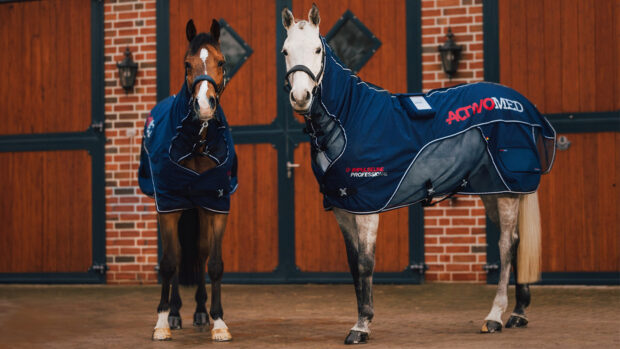From schooling exercises to carrot stretches, horse owners are always working on ways to relieve tension in horses. Calling in an accredited equine practitioner such as a physiotherapist, chiropractor or osteopath is a key part of most horses’ management, but what can you do in between to help relieve tension in your horse? Moreover, how can you detect areas of tension in the first place?
“When horses feel pain or discomfort, they block it out,” explains Jim Masterson, equine bodyworker and pioneer of the Masterson Method. “In the wild, if they’re dragging a leg or showing vulnerability, they become a target. So, what are their options? They’re going to cover it up.”
Over the years, and through careful study, Jim developed bodywork techniques that encourage horses to reveal where in the body they hold tension and begin releasing it. This, Jim says, is often as much a surprise to the horse as it is to the owner.
Jim Masterson: developing the Masterson Method
Jim began working with horses in 1997 as a show groom in Iowa, US. A relative novice at the time, Jim starting paying attention to the work of equine chiropractors and massage therapists who accompanied riders on the show circuit.
“There was this old horse chiropractor from New Zealand who’d been doing it for 40 years – he really knew his stuff,” Jim tells H&H. “I would follow him around whenever he was at the shows, drive him to different barns to hold the horses for him and just pay attention.
“Let’s say he did a big adjustment to the poll-atlas junction at the top of the neck – he would then step back to see what the horse had to say. The horse would kind of stand there and blink a few times and maybe shake, and then start to yawn repeatedly. That was his indication that he got a good adjustment. That’s what got me interested – reading the horse and the horse’s behaviour.”
It was during these years that Jim learned a technique from another equine massage therapist derived from Chinese medicine, and one that forms a key element of his practice.
“She would start by running her fingers very lightly and slowly along the bladder meridian,” Jim explains, “which follows the top line of the horse and goes all the way down the hind end to the hind foot. We call it the bladder meridian technique. You’re just barely touching the hair, moving very slowly, and watching the horse’s eye for a blink or for some change in behaviour that that shows that horse feels something in that spot.
“I found if you stop, wait there and do nothing, the horse would drop his head. Then, he might start to lick and chew or yawn repeatedly, just like they would for the chiropractor. I thought ‘so, there’s a connection here!’”.
How to relieve tension in horses – the bladder meridian technique
All you need to try the bladder meridian technique are your hands.
“People always want to know how much pressure to use,” remarks Jim, “it’s barely any. You’re looking to have an air gap between your horse’s body and your hand. Your fingertips are in light contact, and then there’s a space between the body and the rest of your hand.”
Bladder meridian works by calling your horse’s attention to a site of discomfort in his body, which is often signalled by a blink or twitch.
“Some horses feel nervous or a little threatened when you point out where there’s tension” says Jim. “They’ll start to fidget, but you just wait there and they’ll give you what I call the release response, like licking, chewing or repeated, yawning, snorting and sneezing.”
Jim says he learned later that this technique meant he was working with the horse’s nervous system.
“There’s the part of the nervous system that blocks out and covers up tension in order to survive, the fight or flight. And then there’s another part that releases the tension, the parasympathetic nervous system that controls responses when not under threat. Without using any pressure, you’re showing the horse where the tension is and helping his nervous system to release it. The result is a more comfortable horse, and it can do a lot in the way of building trust and a relationship with him.”
Jim also has a video on how to release tension in horses using the bladder meridian technique.
Tension in horses: how can you spot it?
Jim says horses most commonly carry tension in their poll-atlas junction, the neck-shoulder junction (where the neck joins the trunk under the scapula bone) and the sacroiliac joint.
“When you’re riding, tension can manifest in your horse bending one way more easily than the other,” says Jim. “He might struggle to pick up one canter lead or become disunited, cross-canter behind or buck over fences, for example.”
Jim notes that while sudden changes such as this warrant attention, horses who have displayed these behaviours for years will also benefit from release.
“Horses who’ve gone in this way for decades have usually stiffened in that direction, so it isn’t hurting him anymore,” says Jim. “You can still help by loosening him up, but it won’t be like pushing a button and fixing it.”
You may also be interested in…

Subscribe to Horse & Hound magazine today – and enjoy unlimited website access all year round

Learn how to stretch your horse to help improve suppleness

How to encourage your horse to stretch and relax
Stay in touch with all the news in the run-up to and throughout the Paris Olympics, Royal International, Burghley and more with a Horse & Hound subscription. Subscribe today for all you need to know ahead of these major events, plus online reports on the action as it happens from our expert team of reporters and in-depth analysis in our special commemorative magazines. Have a subscription already? Set up your unlimited website access now.





